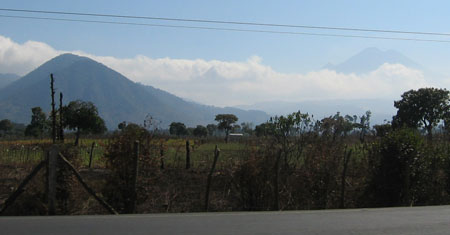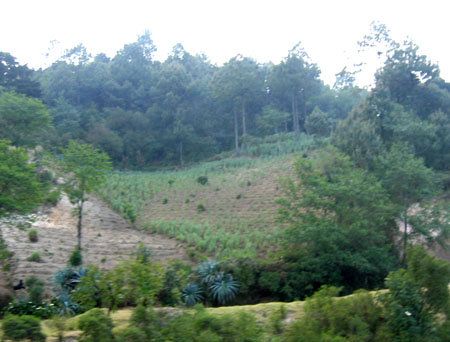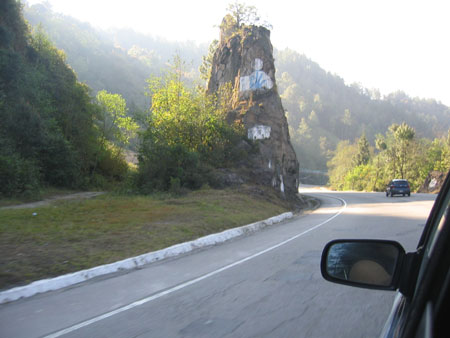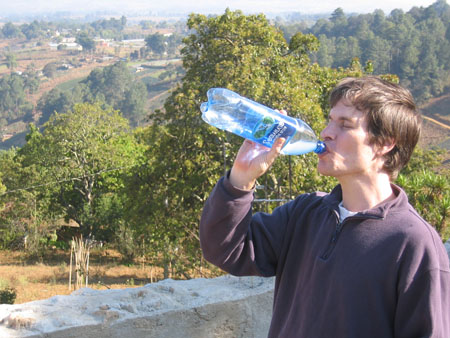|
|
|
Lake Atitlan
Saturday, March 11 2006
setting: Terminal 4, John F. Kennedy Airport, Queens, New York, USA
I'd prepared for today's plane trip by buying a flask of E&J Brandy, much of which I drank in the airport before my flight. I was pretty drunk by the time I climbed onto the TACA flight bound for El Salvador. Evidently I passed out shortly thereafter; we'd been in the air for over an hour by the time I awoke. I hadn't even remembered the plane taking off.
I could tell Central America was going to be beautiful as our plane flew across it. Off in the distance were huge volcanos, perfect cones whose bases were concealed behind the curvature of the Earth.
El Salvador was humid and balmy, just the way one expects the tropics to be, though it wasn't as refreshing as I expected it to be due to the fact that Upstate New York had had temperatures in the 60s when I'd left. At the end of the next leg we landed in Guatemala City, which is over a mile above sea level. Temperatures there were only a little warmer than they'd been back in Hurley.
Gretchen was waiting for me among the huge throng of placard-holding greeters in the Guatemala City airport. She'd already been to the museum and had even taken advantage of a cheap internet cafe outside somewhere in the city. Unlike most cities, Guatemala City's airport is basically in the center of downtown.
We quickly made an arrangement with a cab driver to drive us all the way to to Lake Atitlan, where we'd be spending the night. Normally one doesn't catch a cab when traveling 80 miles, but in Guatemala labor (even in the form of a taxi driver) is a trivial expense. Our driver spoke only Spanish, but that didn't prove to be a problem.
My first feeling about terrestrial Guatemala was surprise at how similar it was to the United States. People were driving a little more aggressively, perhaps, and their cars were a little more beat up. But, aside from the scarcity of SUVs, the cars looked like modern American cars, and the scenery could have passed for a slightly shabbier version of Florida. It was only in the outskirts of Guatemala City that I began to see hallmarks of the Third World: recalcitrant piles of trash, crumbling (though fully occupied) buildings, and the ubiquity of corrugated metal as a construction material, no matter its condition.
Soon, though, we were in the mountains and it was clear we were in a foreign land. The buildings were simple single-story concrete buildings with whips of rebar sticking out of their roofs. Nearly all of the women were dressed in colorful versions of traditional hand-woven Guatemalan clothes, whereas the men wore simple western-style shirts and trousers. These people were, according to the Lonely Planet Guide, the indiginous Maya of the region. Many of them spoke a Mayan language as a primary language and Spanish only when absolutely necessary.
Lake Atitlan live in a caldera resulting from the explosion of a massive volcano some 84,000 years ago. On its south end, two flawless new volcano cones provide a dramatic backdrop that is impossible to accurately capture on camera. Though still geologically unstable, the lakeshore is home to the city of Panajachel and numerous small villages, as well as many smartly-appointed (and architecturally-unique) compounds. Hurricane Stan caused massive damage all around the lake back in October.
Unlike the highlands above the lake, Panajachel is thick with gringo tourists, many of them hippies dressed in Guatemalan clothes. Ever since college I've associated that look with hippies, but only now was I realizing that it was actually a native Guatemalan style. I'd use the adjective "Pre-Columbian," but the saturated colors preferred by modern Guatemalans are strictly post-DuPont. (The lack of subtlety in Guatemalan fabric quickly leads people like me to wonder if perhaps there isn't a huge unsupplied market for earth-tone Guatemalan fabric.)
On the shoreline of Panajachel, we arranged with the operator of a private boat for passage to our destination, one of the smaller villages along the lake (since the sides of the caldera are so steep, and the roads poor, indirect, or non-existent, the best method for moving between shoreline villages is by water). Normally such a boat ride would only a cost a couple dollars at most, but the boat operator lied (we found out later) and told us the next scheduled boat wouldn't be leaving until after dark, so he managed to get us for 200 quetzales, or about $25, a king's ransom in this blighted nation.
We ended up in San Marcos La Laguna, one village shy of our intended destination, because Gretchen refused to pay an unexpected fee of six quetzales for that final leg. She was already suspicious that we'd been ripped off and her sucker brakes are not of the anti-lock variety.
San Marcos is a peaceful little hippie village, full of small hotels, vegetarian restaurants, and lots of dubious businesses dedicated to the alignment of chakras, the rubbing of crystals, and silent meditation beneath pyramidal forms. There are no streets in San Marcos, only narrow paths, only a few of which are paved. It has the feel of a garden maze, one that became increasingly difficult to navigate as darkness fell because there was no municipal lighting. We were in a hurry to find a place to stay, but we hadn't called to make any arrangements beforehand and none of the places we checked had any rooms available. In the end we had to stay in an open dormitory-style room with two other women, though we arranged to be in a loft that afforded us a little privacy, just enough to watch an illegally-duplicated DVD of The 40 Year Old Virgin on my iBook.
The hotel where we were staying also featured a vegetarian restaurant, though they was only one pre-fix on the menu: broccoli surprise with rice. Somehow this simple, flavorless, largely protein-free dish required several hours to make. As we were eating, some guy in a black stovepipe hat came into the restaurant trying to raise a crowd to see a musical performance at some other location in the village. Dude seemed as if he had been snorting a lot of cocaine.
Well into the night, we could hear chanting and singing (not all of it very good) issuing from a PA system somewhere. It sounded superficially like the extended-play call to prayer you hear in Jordan during Ramadan, though the English woman in our dormitory said it was probably one of the local healing centers having a big group chakra alignment (complete with happy endings?).

On the way to Lake Atitlan.

Distant volcanos on the way to Lake Atitlan.

Farming steep slopes in the mountains. Ominously, many hills and mountains are farmed all the way to their summits, and the land is rarely (and then only vaguely) terraced.

Highway through the mountains west of Guatemala City.

Me drinking water, a rare sight indeed.

Locals in the mountains.

Shoreline in Panajachel.

A few high-rise hotels back on the Atitlan coast in Panajachel.
For linking purposes this article's URL is:
http://asecular.com/blog.php?060311 feedback
previous | next |







